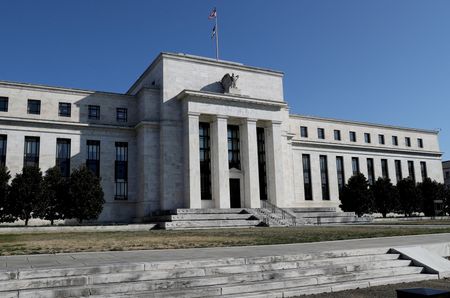By Michael S. Derby
WASHINGTON (Reuters) -At their last monetary policy meeting, Federal Reserve officials mulled financial stability risks that existed in part due to their aggressive campaign of rate rises, as they also expressed concern over the political fight among elected officials over raising the country’s debt limit.
At the Federal Open Market Committee meeting held on Jan. 31-Feb. 1, officials flagged what they saw as potential vulnerabilities in things like commercial real estate and non-bank financial companies, according to meeting minutes released Wednesday.
Some Fed officials were also worried about overseas shocks hitting the U.S. financial system. Others “noted the importance of orderly functioning of the market for U.S. Treasury securities and stressed the importance of the appropriate authorities continuing to address issues related to the resilience of the market.”
The health of the Treasury market has been an issue for some time and was thrown into stark relief by the tumult seen in the sector three years ago when the coronavirus pandemic first struck. A huge rise in government borrowing coupled with a reduced Fed footprint has raised questions about how this market, critical to global credit, will function, especially if faced with new stresses.
At the most recent Fed meeting, officials lifted their overnight target rate range by a quarter percentage point to between 4.5% and 4.75%, as they downshifted the pace of their rate rises aimed at bringing high inflation under control.
The meeting minutes showed that officials believed more rate rises were needed to cool inflation, as policymakers flagged the considerable uncertainty that surrounded the economic outlook.
COLLATERAL DAMAGE RISKS
The Fed has raised rates very aggressively since last March when its target rate stood at near zero levels. While Fed officials have long noted this process could bring pain to the economy, some have said the central bank is mindful of avoiding actions that would break something in the financial system.
That said, many market participants have been worried the swift rise in the cost of borrowing could cause trouble for investors and financial firms, and asset markets have been under considerable pressure from Fed actions, which also include a contraction of central bank bond holdings.
The minutes showed Fed policymakers were also worried about the unsettled efforts by elected officials to raise the nation’s debt ceiling. Raising the debt limit allows the government to borrow to pay expenses Congress has already approved, but some Republicans are seeking to use the limit to extract concessions from Democrats, even as a wide array of private sector analysts warn of the huge risks that strategy poses.
Fed officials appear to agree. “A number of participants stressed that a drawn-out period of negotiations to raise the federal debt limit could pose significant risks to the financial system and the broader economy,” the minutes said.
The minutes also showed officials taking stock of the ongoing massive inflows of cash into what the central bank calls its overnight reverse repo facility, which helps set a floor underneath short-term interest rates. That facility has taken in over $2 trillion per day since last June.
Fed officials have long expected usage of the tool to shrink over time but that has not happened in any meaningful fashion yet. The minutes did not signal what policymakers think will happen next for the reverse repo tool, but they did note that it’s possible as the Fed presses forward with its balance sheet drawdown there could be some turbulence in money markets.
Both Fed staff and policymakers noted the Fed has tools to address wobbly markets. But if significant pressures in funding markets were to arise, “several participants also noted the challenges of addressing potential disruptions in U.S. core market functioning.”
(Reporting by Michael S. Derby; Editing by Andrea Ricci)

